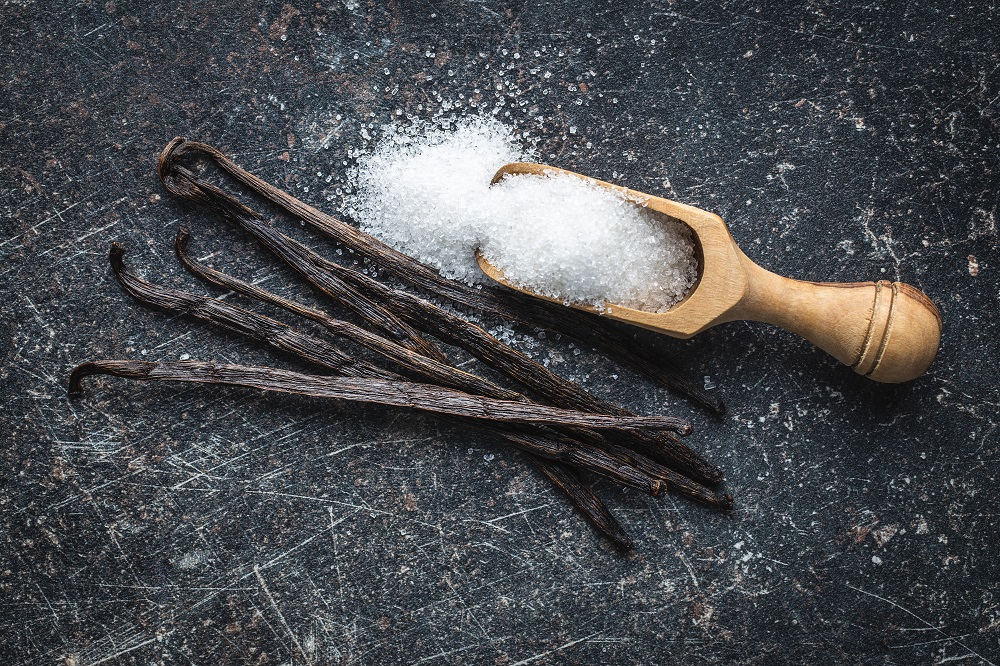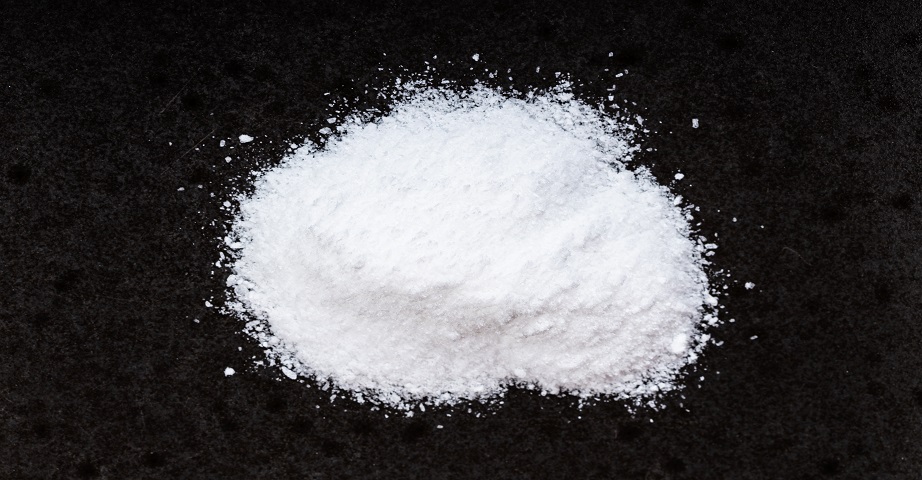Vanillin - a cheaper substitute for vanilla or a valuable chemical compound?

Vanillin is an organic chemical compound that is one of the fragrance ingredients of vanilla. Although it occurs naturally in the plant, it is most often obtained by synthetic way. There is a lot of different information circulating around vanillin, which of them is real? What is vanillin made from? Is the compound harmful? How is vanilla different from vanillin?
Vanillin - what is it?
Vanillin is a mysterious ingredient that can often be found in food products. It is a 4-hydroxy-3-methoxybenzaldehyde (vanillin glucoside), a highly aromatic, organic chemical compound built from the benzene nucleus, which contains three functional groups, namely the aldehyde, hydroxyl and methoxy groups. The vanillin comes in the form of minor crystals ranging in color from white to slightly yellow, and is slightly soluble in water. It is the component of the popular spice, which is vanilla. The vanillin is responsible for the smell and characteristic taste of the vanilla.
The vanillin is most often used in the form of vanilla sugar or powder. Although these products do not have such an intense aroma as vanilla, they are perfect for processing, replacing natural extracts.
Vanillin - how is it created?
The vanillin production from vanilla is unprofitable and would not meet the needs of consumers around the world - the annual vanilla harvest is about 2.2 thousand tons. About 4 tons of the vanillin can be obtained from this amount, while the annual public demand for this ingredient is about 12 thousand tons. Therefore, currently the vanillin is most often obtained by artificial methods, through chemical reactions.
The vanillin is often referred to as a "copycat of vanilla" and the media disseminate false information about it, which means that in society you can often meet myths about the compound.
One of the proclaimed, not entirely true information, is the statement that the vanillin is created from cattle excrement. What is truth? A dozen years ago, Japanese scientists devised a method by which the vanillin can be extracted from cow droppings. Researchers, due to the ecological aspects of the idea, received a prize for it, but the method was not used in the food industry on a large scale, due to the numerous controversies associated with it.
The idea of producing the vanillin from cattle excrement did not delight consumers, therefore the compound was obtained by lignin method, by eliminating lignin during paper production. However, due to the large number of unnecessary products associated with the growing problem of disposal and for environmental reasons, the use of the lignin method on a large scale has been reduced.
Sometimes in the food industry, the vanillin is obtained from eugenol and lingosulfonic acids, but most often the artificial vanillin is obtained from a compound called guaiacol, which is obtained from cloves. However, it is worth emphasizing that guaiacol is a highly toxic compound that is commonly used as a mouth rinse and disinfectant by dentists. Therefore, research is currently ongoing on other methods of obtaining the vanillin, and one of them is to obtain the compound using bacteria.
Health-promoting properties of vanillin
Although the vanillin is considered an artificial replacement for the vanilla and more often you can meet negative statements about the substance obtained synthetically, recent scientific research suggests that the vanillin may also have a health-promoting potential.
Results of experiments conducted on animals indicate that the vanillin may improve liver function, histology and regeneration in the model of organ damage. In addition, the compound can weaken the activity of pro-inflammatory factors and reduce oxidative stress. What is more, the substance can be used to dilate blood vessels, and it can also help reduce the systolic reaction caused by calcium ions.
The synthetically produced vanillin can also be helpful among alcohol abusers - the compound can alleviate anxiety and undesirable, withdrawal symptoms associated with ethanol by regulating neurochemical balance.
The vanillin may have antioxidant effects as well as anti-inflammatory and anti-mutagenic properties. There are also indications suggesting that the compound may have neuroprotective effects in some neurological disorders and neuropathophysiological conditions, but further research is still needed to confirm the beneficial effects of the substance on the human body.
Vanillin and vanilla - differences
Although vanilla and vanillin sound similar, the compounds are slightly different from each other. The vanillin is a chemical compound that occurs naturally in vanilla pods, but the compound available in stores is obtained artificially, being a synthetic replacement for the vanilla. In addition, the vanillin, although it smells the same as the extract obtained from vanilla, is devoid of valuable properties that naturally stand out of the plant. What is more, the synthetically obtained compound is distinguished by a slightly less intense taste than the naturally occurring aromatic spice.
The vanillin used in large quantities can negatively affect the human body, contributing to the occurrence of numerous side effects. The vanilla as a natural substance seems to be a safer solution than its synthetic substitute.

In what products vanillin is present? The use of vanillin
The synthetic vanillin is used in various industries, but most often the substance can be found among food products. The compound is commonly used in the confectionery industry, as an ingredient in vanilla sugar, as well as an addition to desserts, ice cream and cakes. Sometimes the synthetic substitute for vanilla can also be found in instant noodles, as well as in beverages, where the substance is used to limit the participation in sugar and other sweeteners.
The vanillin is also used in the cosmetics industry for the production of perfumes and cosmetics, among others in soaps, shower gels or deodorants, as well as in lip care products. The substance can have a soothing effect on the skin, and can also eliminate unwanted odors and strengthen the note of desired aromatic.
The vanillin, or a slightly stronger substance, which is ethylvanillin, is also used in the production of cigarettes and e-cigarettes as a flavouring material that is added to a cigarette paper or filter, and sometimes tobacco as well.
The synthetic vanilla substitute is also used as an intermediate product in the pharmaceutical industry, where it is used, among others, to mask the bitter taste of medicines, and also as a chemical reagent, for example, during the production of sulfovanillin, a compound, which is used in microscopic examination of fungi. The vanillin can also be found in air fresheners, as well as in car fragrances.
Is vanillin harmful? - Consequences of consuming vanillin
The vanillin used in small amounts should not negatively affect the human body. Used in excess, it can contribute to the occurrence of numerous undesirable ailments. The most often, you can meet with the statement that the vanillin can cause allergic reactions, as well as contact dermatitis, skin irritation, eczema or changes in skin pigmentation, therefore, the compound has been entered in the register of hazardous chemicals (NIH).
Because the vanilla is a natural substance, it is a safer choice than its synthetically obtained replacement. However, it is worth noting that in order to consume a toxic dose of the vanillin, should be consumed about 400 bags of the vanilla sugar.
Vanillin and vanilla - which product to choose?
Paying attention to the method of obtaining vanilla and vanillin and differences between substances, it can be noted that better to use the vanilla sugar instead of the vanillin sugar.
In the natural vanilla sugar, can be found a minimum of 27% of real vanilla in the composition, however, the product is difficult to find on supermarket shelves. Definitely, more often it can be found in health food stores or organic products. It is also worth paying attention to the price of products - the vanilla sugar, obtained from the natural vanilla, which, next to saffron and cardamom, is the most expensive spice in the world, it is much more expensive than commonly available and synthetically obtained the vanillin sugar.
Both products have advantages and disadvantages and are distinguished by their specific properties. The final choice is an individual matter. However, it is important to know what the consumption of individual substances may be associated with and what are the differences between compounds whose names sound similar.

